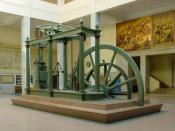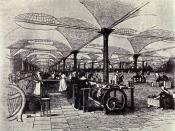The industrial revolution in Britain was a long and gradual development. The favorable conditions in England were why industrialization took place earlier and faster than other countries at the time. The lack of physical barriers and the many canals helped with transportation of goods. Coalfields and thick forests, located close to large deposits of metal ores, provided fuel to power the furnaces that produced iron. Thriving commercial banks provided financing for investments in industrial plants and machinery. Advances in agriculture also contributed to the industrialization process. Beginning in the mid-17th century, England underwent a process of agricultural improvement that enabled fewer farmers to feed more people while cultivating the same amount of land. Between 1750 and 1800, grain yields rose 50 percent; this increase supplied the steadily rising population, which in England grew from 5.5 million in 1750 to around 9 million in 1801, to over 16 million by 1851.
Agricultural improvement not only produced more food at cheaper prices, it also allowed farms to produce more food with fewer workers. Workers who could no longer find work on farms migrated to the towns in search of employment. As a result, there was a dramatic shift in population during the 19th century from the agricultural southeast to the Midlands and the north, where industry was located.
The production of cotton clothing was the center of industrialization. In the beginning of the 1800's Britain exported cloth from Indian than England became the main supplier of cotton. The availability of raw cotton of America and Egypt and the invention of the spinning jenny were two developments that made it possible. . It used foot pedals to control the spinning of multiple threads. This device allowed a worker to spin 200 times as much thread in 1815 as could be spun 50 years...


